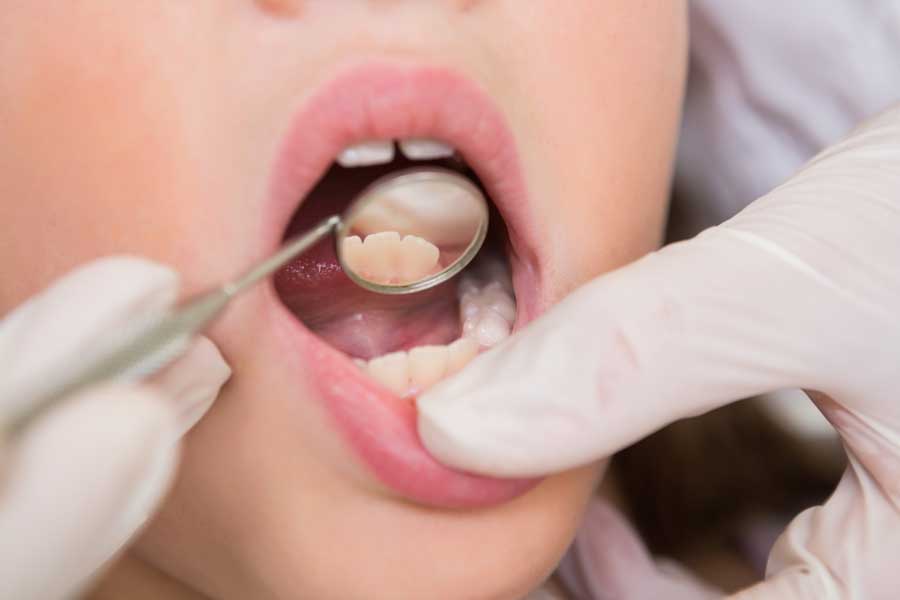
Pulpotomy
According to the National Institute of Dental and Craniofacial Research, approximately 42% of all children between the ages of 2 and 11 suffer from cavities.
Severe dental decay of the baby teeth can inflame the pulp, which is known as pulpitis. When this happens, a pulpotomy is necessary to protect and treat the teeth. Please continue reading for an overview of the pulpotomy procedure.
What is a Pulpotomy in Dentistry?
The pulp is the innermost part of the tooth and it comprises the blood vessels and nerves. However, sometimes, if dental decay is allowed to continue, then the pulp can get inflamed and infected. Pulpotomy in dentistry is a procedure in which the pulp is removed from the teeth in order to protect the remaining teeth from complete damage and decay. Essentially, pulpotomy is a type of root canal treatment, one that focuses primarily on the removal of the unhealthy pulp. A pulpotomy procedure is usually conducted on baby teeth, but it may also be done on adult teeth in some cases.

Symptoms of Pulpotomy
As previously mentioned, the pulp of the tooth holds all of the essential nerves and blood vessels. Inflammation of the pulp can be extremely dangerous and painful. However, depending on the spread of infection, pulpitis may either be reversible or irreversible.
Reversible pulpitis can easily be treated with over-the-counter medication and it only hurts when you touch the top of the tooth.
Irreversible pulpitis is far more dangerous and can lead to serious symptoms such as:
- Extensive toothache.
- Shaky and trembling tooth.
- Inflammation in the soft tissue even if you don’t have gum disease.
- Sensitive and red gums.
Schedule your Pulpotomy Appointment
Pulpotomy Procedure
Before conducting the pulpotomy procedure, the dentist will first have to diagnose the issue. The dentist will run an x-ray exam, which will reveal a deep dental decay in the tooth. The dentist will have to decide if it’s possible to repair or save the tooth after the decayed parts are removed. If the decay is too deep, the tooth may just require tooth extraction. In some cases, the dentist may also have to make other arrangements to facilitate the proper eruption of the permanent teeth.
The dentist will also have to decide if the nerve within the pulp is still healthy. If the nerve is still healthy, the dentist will only need to remove the infected pulp through the pulpotomy procedure. However, if the nerves are dead, then the dentist will need to conduct a root canal treatment or pulpectomy to remove the infected pulp and the nerves. Based on these factors, the dentist will decide if the tooth is ready for the pulpotomy procedure.
Even when it comes to treating the inflamed nerve, there are two approaches that the dentist could potentially go for — indirect pulp cap or pulpotomy.
Indirect Pulp Cap is a procedure in which the dentist won’t remove the pulp chamber of the nerves. Instead, the dentist will medicate the region to control the inflammation and save the teeth. This, however, may not always be possible.
Pulpotomy will usually be the second approach since it’s more invasive. This is a procedure in which the dentist will remove the pulp above the nerves that go into the tooth’s root. In addition to removing the infected pulp, the dentist will also medicate the region with the nerves to minimize the inflammation and save the nerve from further damage.
After the pulpotomy procedure, the tooth will be restored. If the infected tooth was a molar, the dentist may use a stainless steel crown. If the infected tooth was one of the front teeth, the dentist may use composite resin or other similar materials.
How to Prevent Pulpotomy in Primary Teeth?
If you don’t want to have to go through the pulpotomy procedure, then you need to protect your children’s teeth and encourage oral hygiene habits. The following are some tips that can help you prevent pulpitis or the need for pulpotomy:
- Your children should use a fluoride toothpaste to brush their teeth at least twice a day.
- They should regularly rinse their mouth with an antibacterial mouthwash.
- You should also take your kids to regular dental cleaning appointments at intervals of 6 months. The dentist or dental hygienist will ensure that there’s no plaque and tartar accumulation and they’ll catch the disease before they get severe.
What is the Treatment to Prevent Root Canal?
Root canal is a serious procedure in which the dentist has to drill into the affected tooth and remove all of the pulp along with the nerves. This saves the tooth but it also completely weakens it, thus necessitating a dental crown to protect the tooth from further damage. However, if it’s not too late, the pulpotomy procedure can potentially prevent root canal altogether.
Pulpotomy is a similar procedure to root canal. But, as already discussed, pulpotomy only necessitates the removal of the infected pulp and not the live nerves. Instead, the dentist focuses on saving the nerves and medicating it to prevent inflammation. If the infection hasn’t yet killed the nerves, then a pulpotomy is the perfect treatment to prevent a root canal.
Schedule your Pulpotomy Appointment
At URBN Dental Uptown , we thoroughly assess your children’s teeth to determine how much of the tooth has been infected. Our primary goal is to protect the teeth completely and use the least invasive procedures. We only resort to pulpotomy if necessary and avoid using other more complicated procedures, unless we have to. For more information, please schedule your pulpotomy appointment today.
